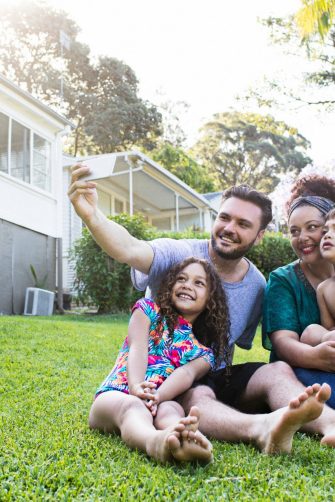New child protection sector reforms can help reduce the number of Aboriginal and Torres Strait Islander children in out-of-home care in New South Wales.
The NSW government has earmarked significant reforms that will aim to return Indigenous children to their families from a child protection system in crisis, including the creation of a restoration ‘taskforce’.
The proposed restoration program will partner with Indigenous community-controlled organisations, which will have a greater input on approaches to reduce the number of Aboriginal and Torres Strait entering care, with its main focus on returning Aboriginal children to families and communities where safe. It was announced following the first meeting of the Ministerial Aboriginal Partnership Group (MAP Group) – experienced Indigenous leaders, policy experts, and community practitioners appointed to advise the state government on redesigning the child protection system.
Aboriginal and Torres Strait Islander children make up 42 per cent of children in out-of-home care but represent just 5.9 per cent of the total child population in Australia. Children growing up in out-of-home care are more likely to experience poor health, development, and education outcomes, and encounter the criminal justice system.
Experts say the current system focuses on removals rather than interventions that support families staying together while keeping children safe. Instead, Aboriginal experts have long called for reunification or restoration, where children are supported to return to their birth families as soon as it is safe to do so.
“Reunifying Aboriginal families is integral to reducing the over-representation of Aboriginal children in out-of-home care,” says Dr BJ Newton, a Wiradjuri woman and child protection policy expert at the Social Policy Research Centre, UNSW Arts, Design & Architecture. “It starts with a shift towards sustaining rather than separating Aboriginal families, and leaving behind a system that focuses on removal, which we know is costly, ineffective and harmful.”
Media enquiries
For enquiries about this story and interview requests please contact Ben Knight, News & Content Coordinator, UNSW Arts, Design & Architecture.
Phone: (02) 9065 4915
Email: b.knight@unsw.edu.au
Dr Newton is a MAP Group member advising the NSW state government on how to reduce the overrepresentation of Aboriginal children in out-of-home care. The group was formed following a forum where more than 100 Aboriginal community and sector representatives proposed measures to reform the child protection system.
Dr Newton’s research on the Australian Research Council project Bring Them Home, Keep Them Home – the first Aboriginal-led research into the reunification of First Nations families worldwide – has been critical to uncovering community insights that informed the vision and announcement of the ‘taskforce’. The research is in partnership with AbSec; the NSW Child, Family and Community Peak Aboriginal Corporation, Waminda; the South Coast Women’s Health and Wellbeing Corporation; South Coast Medical Services Aboriginal Corporation (SCMSAC); and Illawarra Aboriginal Corporation.
“We’ve found that restoration is viable for many families and can reduce the number of Aboriginal children in out-of-home care, but the system is failing,” Dr Newton says. “As a result, Aboriginal children are missing out on connections to family that are vital for their wellbeing and sense of belonging.”
An Aboriginal community-led approach to reunify families
Aboriginal families face complex challenges in reunifying with children removed to out-of-home care, Dr Newton says. The research has been key in generating the knowledge needed to inform a policy shift towards bringing Aboriginal children home and keeping them home that is backed by community.
“This is an innovative solution that has come directly from community-informed research and experiences of Aboriginal parents and families, and also Aboriginal practitioners who have identified that restorations are not happening,” Dr Newton says. “This isn’t just another government exercise that public servants have concocted but is instead informed by evidence and from what the Aboriginal community wants and needs.”
Dr Newton specialises in participatory and community-based methods to develop the knowledge and evidence base of Aboriginal people from their perspective.
“We need to understand the importance and the power of non-traditional research,” Dr Newton says. “This work directly impacts families stuck in the system, caseworkers on the ground, and senior bureaucrats making decisions.”
Reunifying Aboriginal families is integral to reducing the over-representation of Aboriginal children in out-of-home care.
One of the key insights from the Bring Them Home Keep Them Home research is recognising the effectiveness of Aboriginal community-led approaches and partnering with communities.
“We’re calling for the taskforce to be re-named the Aboriginal Authority for Restoring Children (AARC),” Dr Newton says. “It better represents the systemic and structural changes that need to happen to the child protection system to highlight the journey of children coming home under Aboriginal authority and self-determination.”
However, for restoration to succeed, greater investment must be made in cultural services to support families to reunite, Dr Newton says. Less than 20 per cent of funding for child protection services is currently received by Aboriginal community-led organisations.
“We have envisioned the AARC to operate locally within Aboriginal communities and organisations where the restoration practitioners are working in collaboration with non-government organisations, with departments across child protection, health, education and housing, to provide a holistic approach to support children and families to reunite,” Dr Newton says.
“We’re now imploring the NSW government to place their confidence and trust in Aboriginal communities and community-controlled organisations that know how to best design and implement programs to meet the needs of their families.
“It’s a new way of working, but one we are confident is a positive step forward and can affect the status quo through genuine partnership and Aboriginal communities leading the way.”
Related stories
-

Giving Aboriginal students and communities a voice in schools
-

Bring Them Home, Keep Them Home: reunifying Aboriginal families
-

How 'closing the gap' may close doors for First Nations women in new plan to end violence
-

Reunifying First Nations families: the only way to reduce children in out-of-home care





